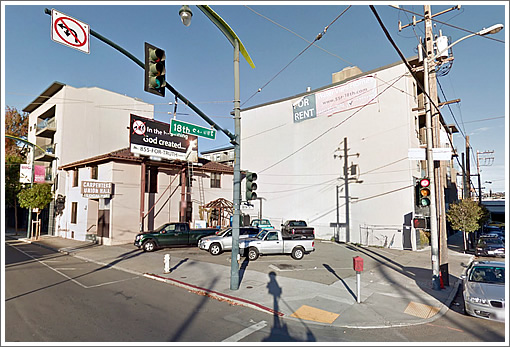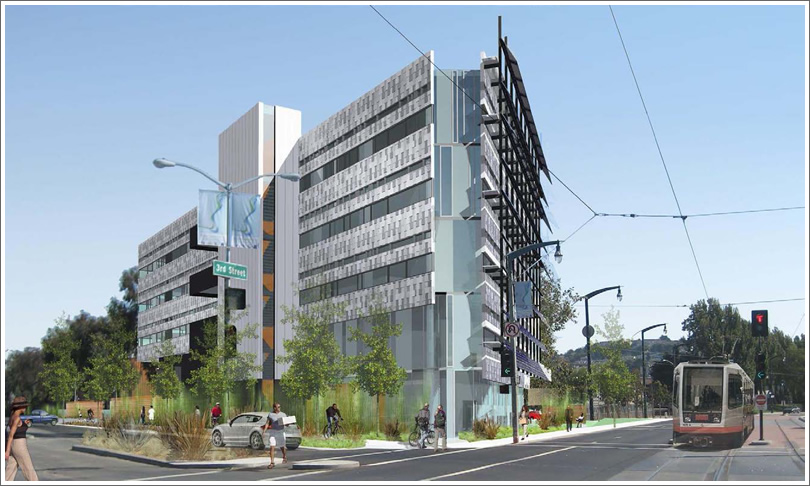The United Brotherhood of Carpenters and Joiners of America Local Union 22 is planning to construct a five-story office and assembly building for the union at the corner of Third Street and Cargo Way, just south of the Islais Creek Channel at the entrance to Bayview, a site which has been sitting vacant since a gas station and car wash on site were demolished in 1999.
Local Union 22 is currently located on the other side of the Islais Creek Chanel, at the corner of Third and 18th Streets, and plans for their corner Dogpatch parcel that’s zoned for development up to 68-feet in height should soon be drawn.


I hope they build it out of wood….
Will they decide to use non-union workers to save money on the build out?
Isn’t this area PDR zoned? If this wasn’t for a union, Jim Meko and his cadre of “activists” would be out in force protesting it.
Whoa. I’ve been waiting for their new building. Was not expecting a 5 story structure. Any guess if it will be partial rented out? The views should be pretty fine from the top floors…
I’ve been to several Dogpatch Neighborhood Association meetings and there’s always a union guy that brings a different family along and drills every project about their commitment to union jobs with stories how their workers need local jobs so they can afford to live in the neighborhood.
The problem with union jobs is that union rates are driving up the cost of construction and thereby the cost of housing. And with those higher rates, you don’t necessarily get more skilled workers; just union workers.
Firstly, they better use all union labor for their building.
Secondly, they must be doing pretty well if they can afford to build this building, or even qualify for financing.
Thirdly, maybe they can lower their union dues so their own workers can take home more of the paycheck.
I’m guessing that much if not all of the cost of their new Bayview building will be covered by proceeds from the sale of the much more valuable land under their old offices, or from the sale of the developed condos. If they own the land the old building is on, plus the parking lot, and can build to 68 feet, there is quite a bit of value to claim from development.
Enjoy the smell of your local neighborhood rendering plant!
yes this will be built union. duh. concrete construction.
dues are low <$25/mo.
no unions aren’t driving up the cost of construction. labor comprises less than a quarter of construction value. in such a superheated construction environment the builders’ earning before interest & taxes are about as high if not higher (at least they were in 2007). just as an example, public construction prices dropped by 25% during the bust even as wages stayed the same.
@MBuddha … Labor a quarter of construction cost??? You don’t know what you’re talking about. The rule of thumb for most of the country is 50/50 but in places like NYC & SF that rule is out the window and is closer to 30/70. Why else would it cost twice as much to build here (and NYC) than in the Midwest, and even more than that than in the South? It’s not like the basic building blocks cost significantly more (maybe a little extra due to higher storage fees).
Prices dropped during the bust because some material prices went down during the global glut (steel for example) but mostly due to labor. Contractors could no longer bid whatever they wanted because they couldn’t cherry pick like the boom years. Wages may not be the only factor here, but they do contribute very directly to what a contractor will bid and with union wages being higher than non-union, it has a direct influence on the final construction cost. Go ahead and drink your Kool-Aid, just stop trying to convince the rest of us. Some of us have been around for a long long time.
@TBK. Yes 25% for direct construction labor. The rest is for admin/white collar labor, fringes, supplies, fuels, depreciation, and of course profit. This is pretty much the same around the US; the EBIT changes depending on how hot the state’s construction market is but the basic breakdown is the same. You can check the Census of Construction for state-level numbers and can play with SF’s certified payroll records system to see how it plays out on various types of projects here in San Francisco. I’ll guess the reason people think the breakdown is 50/50 is because the only costs really shown owners are the hourly construction labor costs and the basic materials. Everything else is embedded in those prices.